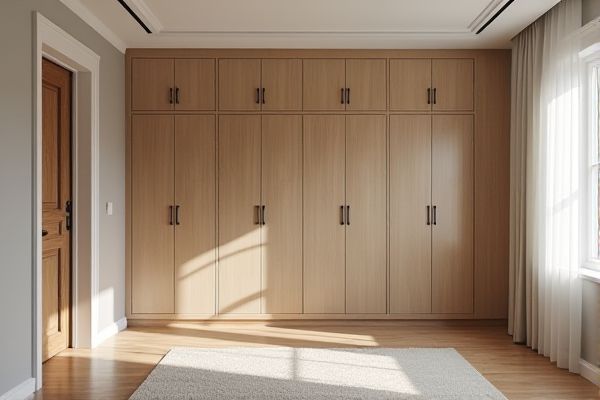
Foldaway lockers offer space-saving convenience by folding flat when not in use, ideal for compact areas, while freestanding lockers provide sturdy, stationary storage solutions with greater durability and accessibility. Explore the rest of the article to discover which locker type best suits your storage needs and lifestyle.
Table of Comparison
| Feature | Foldaway Lockers | Freestanding Lockers |
|---|---|---|
| Space Efficiency | High - folds flat for storage | Moderate - fixed footprint |
| Installation | Easy, minimal setup | Requires floor placement, sometimes bolting |
| Mobility | Portable and lightweight | Stationary and heavy |
| Durability | Moderate - often made of plastic or lightweight materials | High - typically metal or heavy-duty materials |
| Security | Basic locking mechanisms | Advanced locking options available |
| Use Case | Temporary storage, events, mobile setups | Permanent storage in gyms, schools, workplaces |
| Cost | Generally lower | Higher initial investment |
Introduction to Foldaway and Freestanding Lockers
Foldaway lockers save valuable floor space by folding against the wall when not in use, making them ideal for tight or multipurpose areas. Freestanding lockers offer robust, standalone storage units that can be placed anywhere, providing flexibility in layout and easy access. Your choice depends on space availability and the need for either compact storage or movable solutions.
Key Differences Between Foldaway and Freestanding Lockers
Foldaway lockers feature a collapsible design that maximizes space efficiency and ease of storage, while freestanding lockers offer permanent placement with sturdy construction and greater durability. Foldaway lockers are ideal for temporary or flexible environments, providing portability and quick setup, whereas freestanding lockers provide ample storage capacity suitable for long-term use in schools or gyms. The choice hinges on the need for mobility versus stability and space availability within the facility.
Space Efficiency: Foldaway vs Freestanding Lockers
Foldaway lockers excel in space efficiency by allowing users to collapse and store them when not in use, making them ideal for environments with limited floor area. Freestanding lockers require a permanent footprint, occupying consistent space regardless of usage, which can limit room flexibility. In high-density or multi-purpose spaces, foldaway lockers provide a significant advantage by maximizing usable area without compromising storage capacity.
Durability and Security Comparison
Foldaway lockers offer moderate durability due to their foldable design which may compromise structural strength compared to freestanding lockers built with robust steel or heavy-duty materials for long-lasting use. Security is typically higher in freestanding lockers as they feature integrated locking mechanisms and reinforced construction, while foldaway lockers might have simpler locks, making freestanding options more reliable for safeguarding valuable items. Your choice should consider the trade-off between portability in foldaway lockers and the enhanced durability and security provided by freestanding lockers.
Installation and Setup: What to Expect
Foldaway lockers require minimal installation, often designed for quick wall mounting with basic tools, making setup straightforward and space-efficient. Freestanding lockers typically involve no installation, as they come fully assembled or with simple assembly instructions, offering flexibility to move or rearrange your storage as needed. Your choice depends on whether you prioritize a fixed, compact solution or a versatile, movable option for your space.
Cost Considerations for Both Locker Types
Foldaway lockers typically offer a cost-effective solution due to their space-saving design, which can reduce the need for additional storage areas, lowering overall facility expenses. Freestanding lockers often entail higher upfront costs because of their robust construction and larger footprint, but they provide greater durability and easier access for multiple users. Your choice depends on whether initial investment or long-term convenience and capacity are more critical for your storage needs.
Versatility and Adaptability in Various Environments
Foldaway lockers offer exceptional versatility and adaptability, easily folding away to save space in compact or multifunctional environments. Freestanding lockers provide stable, permanent storage solutions ideal for traditional settings demanding durability and accessibility. Your choice depends on the flexibility needed for changing spaces versus long-term, fixed storage requirements.
Maintenance and Longevity Factors
Foldaway lockers offer enhanced maintenance ease due to their compact design, which reduces exposure to dust and physical damage, thereby extending their lifespan. Freestanding lockers, while sturdy, require regular cleaning and periodic inspections to prevent rust and wear, particularly in high-traffic environments. Material quality and hinge mechanisms are critical factors influencing the longevity of both types, with stainless steel and reinforced steel hinges providing superior durability.
User Experience and Accessibility
Foldaway lockers provide enhanced space efficiency by folding flat against the wall, allowing easier access in cramped environments and offering quick retrieval for users with limited mobility. Freestanding lockers offer greater flexibility in placement and organization, accommodating diverse user preferences but may require additional clearance space for full door access. Both designs can be equipped with user-friendly locking mechanisms and customizable heights to improve accessibility for individuals with disabilities.
Choosing the Right Locker: Foldaway or Freestanding?
Foldaway lockers offer compact storage solutions ideal for maximizing space in small or multi-purpose areas, as they easily collapse when not in use. Freestanding lockers provide robust, permanent storage with increased durability and customization options suitable for high-traffic environments. Selecting between foldaway and freestanding lockers depends on space availability, frequency of use, and the need for portability versus stability.
 homyna.com
homyna.com